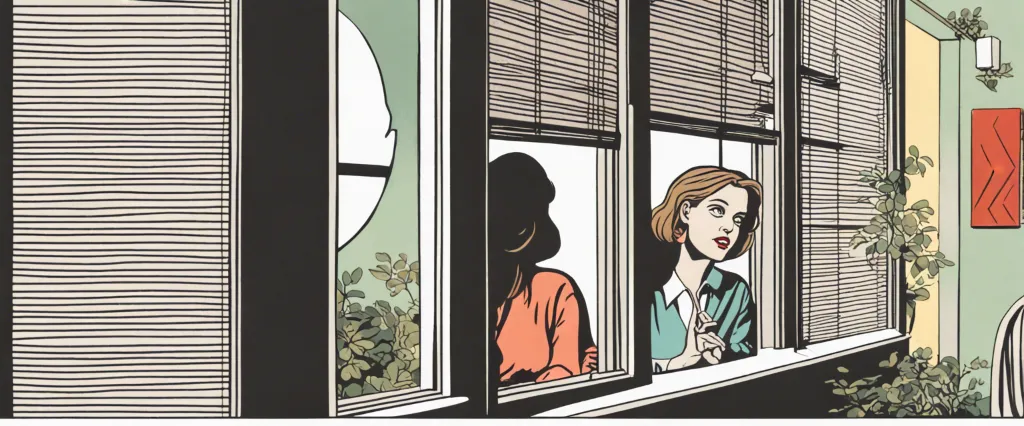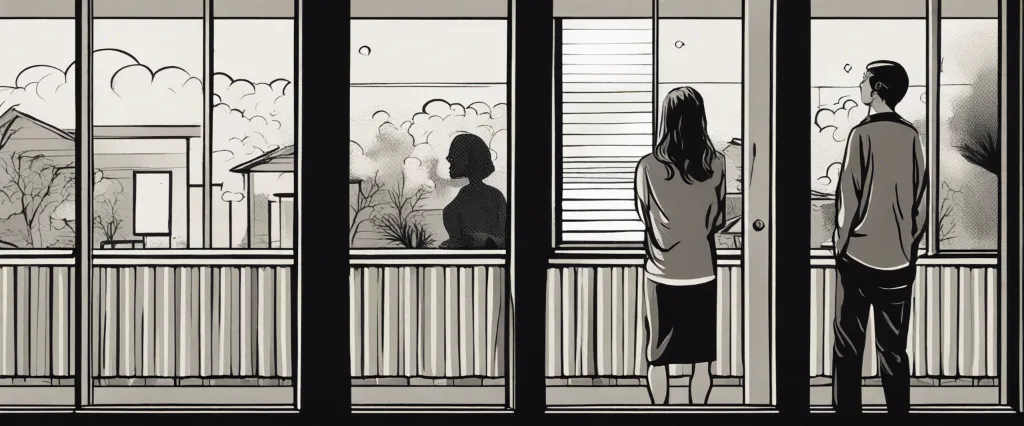
In “Thy Neighbor’s Wife,” acclaimed journalist Gay Talese delves into the complex and often taboo world of sexuality and desire. With meticulous research and a masterful storytelling approach, Talese weaves together a captivating narrative that blurs the boundaries between journalistic inquiry and personal involvement. As a distinguished figure in the field of New Journalism, Talese is best known for his in-depth investigations and his ability to capture the essence of a subject. Through “Thy Neighbor’s Wife,” he once again demonstrates his unparalleled skill in uncovering the intimate secrets and hidden desires of ordinary people, challenging societal norms and shedding light on the often conflicting landscapes of love, marriage, and sexuality.
Chapter 1: The Sexual Revolution: Changing Attitudes and Behaviors
Chapter 1 of “Thy Neighbor’s Wife” by Gay Talese explores the sexual revolution that took place in America during the 1960s and 1970s. The chapter begins with an introduction to the author’s personal experiences and observations regarding the changes in attitudes and behaviors towards sex during that time.
Talese introduces the concept of sexual liberation and describes how the sexual revolution challenged societal norms and traditional values. He discusses the early activism by pioneers like Margaret Sanger, who fought for birth control rights, and the subsequent development of the birth control pill, which had a profound impact on sexual behavior.
Talese delves into the sexual practices and alternative lifestyles that emerged, such as wife swapping, swinging, and communes. He provides a detailed account of his visit to Open Land, a commune in California, where he explores the dynamics of communal living and the dismantling of monogamous relationships.
The chapter also examines the impact of the sexual revolution on the pornography industry, as well as the rise of nudist colonies and the nudist movement. Talese interviews individuals involved in such activities, gaining insights into their motivations and experiences.
Throughout the chapter, Talese juxtaposes his personal experiences with his journalistic investigation, showcasing his talent for vividly describing the sights, sounds, and emotions surrounding this sexual revolution.
In conclusion, Chapter 1 of “Thy Neighbor’s Wife” provides an in-depth exploration of the sexual revolution in America, capturing the changing attitudes and behaviors towards sex during the 1960s and 1970s. Talese’s engaging storytelling and extensive research offer a compelling look into the various aspects of this societal transformation.
Chapter 2: The Suburban Swingers: Exploring the World of Swinging Couples
Chapter 2 of “Thy Neighbor’s Wife” by Gay Talese, titled “The Suburban Swingers: Exploring the World of Swinging Couples,” delves into the secretive and unconventional sexual practices of couples living in suburban America during the 1970s.
Talese initiates the chapter by recounting his experience attending a suburban swingers party in California. He provides a detailed description of the participants, their extravagant clothing, and the various rooms where sexual encounters take place. The author’s objective is to uncover the motivations and dynamics behind the swingers’ chosen lifestyle.
As he converses with attendees, Talese learns that many of these couples are married and live mainstream lives, holding jobs and raising families. However, they choose to engage in extramarital activities, driven by a desire to break free from society’s constraints and explore their sexuality.
The author provides ample insight into the emotions and thoughts of the swingers he interviews. He notes that swinging provides a sense of adventure, liberation, and a newfound exploration of one’s desires. Additionally, Talese highlights the apparent lack of jealousy among these couples, as they separate sex from emotional attachment.
Talese also explores the reasons people become swingers, touching upon topics such as dissatisfaction with monogamy, a desire to combat boredom and routine, and the urge to challenge societal norms. By participating in swinging, these suburban couples seek a broader range of sexual experiences while maintaining their committed relationships.
In conclusion, this chapter of “Thy Neighbor’s Wife” offers a detailed and insightful account of the world of suburban swingers during the 1970s. Talese investigates the motivations behind their choices and sheds light on the complex dynamics that govern their unconventional lifestyle.
Chapter 3: The Voyeur’s Motel: Peeping into the Lives of Others
Chapter 3: The Voyeur’s Motel: Peeping into the Lives of Others of Gay Talese’s book Thy Neighbor’s Wife introduces the unique character of Gerald Foos, a motel owner in Aurora, Colorado with an unconventional secret. The chapter begins with the author’s visit to Foos’ motel, named Manor House, where Foos reveals his real interest lies not in providing lodging, but rather in observing his guests’ private lives.
Foos discloses that he has spent two decades transforming the attic above the motel into a secret viewing platform, complete with ventilation holes disguised as vents in the ceiling. From this vantage point, Foos confesses to voyeuristically watching and documenting his guests’ most intimate moments. He considers himself a researcher of human behavior, priding himself on his meticulous observations.
The author becomes intrigued by Foos’ confession and delves deeper into his history. It is revealed that Foos’s voyeurism began in the 1960s, when he first constructed the observation platform. He recounts particular incidents, such as instances where he witnessed guests engaging in sexual activities, cheating on their partners, or having conversations about personal matters they presumed were private.
Talese is simultaneously fascinated and repulsed by Foos’ actions. He acknowledges the moral ambiguity of voyeurism, considering the violation of privacy involved. At the same time, he recognizes the profound insights into human behavior that Foos’ observations have provided.
Throughout the chapter, Talese questions the ethical implications of Foos’ actions and the level of trust he has breached. Nevertheless, he is captivated by Foos’ detailed records, in which the motel owner has compiled and labeled events that showcase the private lives of the countless guests who have stayed at the Manor House.
Chapter 4: The Prostitution Industry: Inside the World of Sex Work

Chapter 4 of “Thy Neighbor’s Wife” by Gay Talese dives into the world of the prostitution industry. Talese explores different aspects of the sex work industry, offering a comprehensive overview of its inner workings.
The chapter begins with an exploration of Nixon’s presidency and its impact on the sex industry. Talese delves into the moral debates surrounding sex work during this time, highlighting the contradictory policies and perspectives that existed. He introduces various individuals involved in the business, including pimps, madams, and prostitutes, shedding light on their motivations and experiences.
Talese discusses the evolution of the prostitution industry, from well-established brothels to streetwalkers and call girls. He describes the development of escort services, providing insight into how they operated and how women were recruited into this profession. Talese also offers observations on the hierarchy within the industry, highlighting the roles of pimps and the control they exerted over prostitutes.
Furthermore, the chapter explores the underground economy that surrounded the business of sex, showcasing the various ways in which money was exchanged and the measures taken to avoid legal prosecution. Talese notes the involvement of organized crime in some areas, further complicating the already intricate world of prostitution.
With a combination of interviews, personal anecdotes, and research, Talese delves into the personal lives of sex workers and the societal factors that influence their choices. He grapples with the paradoxical attitudes towards sex work, examining both its condemnation and the underlying demand that sustains it.
Overall, Chapter 4 of “Thy Neighbor’s Wife” provides a comprehensive and nuanced portrayal of the prostitution industry, offering readers a glimpse into the complex and often misunderstood world of sex work.
Chapter 5: The Homosexual Community: A Look at Gay Culture and Identity
Chapter 5 of Gay Talese’s book “Thy Neighbor’s Wife” explores the gay community, focusing on its culture and identity during the time it was written, in the late 1970s. The chapter presents a comprehensive and in-depth analysis of the gay community, shedding light on the various aspects of their lives and the challenges they face in a predominantly heterosexual society.
Talese begins by highlighting the clandestine and secretive nature of the gay community, with members often living double lives due to fear, social stigma, and legal repercussions. He then delves into the origins and evolution of gay culture, examining how it developed as a form of resistance and self-expression in the face of discrimination.
The author explores different facets of gay culture such as gay bars, drag shows, leather clubs, bathhouses, and the role of pornography in shaping gay identity and community. Talese also investigates the dynamics of gay relationships, looking at both committed partnerships and casual encounters prevalent within the community.
Throughout the chapter, Talese emphasizes the diversity within the homosexual community, recognizing that individuals have varied interests, lifestyles, and identities. He highlights the struggles faced by gay individuals, ranging from discrimination and alienation to the fear of AIDS, which was beginning to emerge during that time.
In summary, Chapter 5 of “Thy Neighbor’s Wife” provides a comprehensive examination of the gay community, its culture, and identity during the late 1970s. It explores the challenges faced by individuals within the community, the underground nature of their lives, and the various aspects that shape their identity and sense of belonging.
Chapter 6: The Pornography Business: Behind the Scenes of Adult Entertainment
Chapter 6 of the book “Thy Neighbor’s Wife” by Gay Talese delves into the adult entertainment industry, specifically focusing on the production and distribution of pornography. Talese provides a comprehensive overview of the inner workings of this business, shedding light on the various figures, organizations, and legal battles that shape the industry.
The chapter begins by introducing Roselli, a businessman who runs the Mafioso-like operations of several adult movie theaters. Talese describes these theaters as being shrouded in secrecy, with hidden doorways and strict rules for entry. Despite facing constant legal battles, Roselli remains defiant and cunning, using corrupt politicians and lawyers to navigate the challenges posed by obscenity laws.
The author then explores the world of adult movie production, highlighting the key players involved. From directors and actors to cameramen and set designers, Talese vividly portrays the unique and explicit nature of their work. He also delves into the controversial issue of consent within the industry, raising questions about the potential exploitation of performers.
Additionally, Talese investigates the business side of the pornography industry, discussing the role of distributors and retailers. He describes how these individuals benefit from the demand for adult content, often operating under multiple aliases to evade legal repercussions. Despite facing constant scrutiny and backlash, these distributors shape the market for adult entertainment, both online and offline.
In Chapter 6, Talese provides readers with an unfiltered look into the inner workings of the pornography industry. He showcases the legal battles, the individuals involved, and the societal implications surrounding the production and distribution of adult content. Through in-depth reporting and personal interviews, the chapter reveals the complex and often shadowy industry that operates behind the scenes of adult entertainment.
Chapter 7: The Sexual Underground: Uncovering Taboo Practices and Fetishes
Chapter 7 of “Thy Neighbor’s Wife” by Gay Talese delves into the exploration of the sexual underground and the uncovering of taboo practices and fetishes. Taking place in the 1970s, the chapter focuses on various individuals and communities who engaged in unconventional sexual activities. Talese paints a vivid picture of this hidden world, shedding light on previously unexplored aspects of human desires and the pursuit of sexual fulfillment.
The chapter begins with the author attending a swingers’ party, where couples engage in consensual partner swapping and sexual exploration. Talese provides a detailed account of the party, capturing the excitement, curiosity, and openness among its participants. Through interviews with various attendees, he highlights their motivations, experiences, and the impact these encounters have on their relationships and personal lives.
Moving beyond the swingers’ scene, Talese investigates other taboo practices, such as sadomasochism and bondage. He interviews individuals involved in these activities, giving readers a glimpse into their psychological motivations and the dynamics of power and control within their relationships. Talese also explores the underground pornographic industry, profiling actors, producers, and consumers to give a comprehensive understanding of this secretive world.
Throughout the chapter, Talese aims to humanize and destigmatize these unconventional practices, offering an introspective look into the lives of those involved. He challenges society’s moral judgments, questioning why certain sexual preferences are deemed unacceptable or taboo. By portraying the individuals as “normal” people with their own desires and needs, he encourages a more open-minded and accepting attitude towards diverse forms of sexual expression.
In summary, Chapter 7 of “Thy Neighbor’s Wife” uncovers the sexual underground, revealing various taboo practices and fetishes of the 1970s. Talese offers an in-depth exploration of swingers’ parties, sadomasochism, bondage, and the pornographic industry, shedding light on the motivations, experiences, and impact of these activities on individuals and relationships.

Chapter 8: The Legal and Moral Debate: Society’s Reaction to Sexual Freedom
Chapter 8: The Legal and Moral Debate: Society’s Reaction to Sexual Freedom, from the book Thy Neighbor’s Wife by Gay Talese, delves into the reactions and attitudes of society towards the emerging sexual freedom in 1960s America.
Talese explores various legal battles that arose during this period and the social impact they had. He starts by examining the case of Ralph and Edith Ginzburg, who were targeted and convicted for publishing explicit material. This case highlighted the growing tension between the right to freedom of expression and the prevalent conservative values of the era.
The author then explores the debate surrounding obscenity laws, detailing the trial of a bookstore owner, Charles Rembar, who successfully challenged the interpretation of these laws. Rembar’s victory was instrumental in reshaping the legal landscape concerning sexual content and protecting individuals’ rights to access and distribute explicit materials.
Furthermore, Talese examines the moral dilemmas that accompanied the sexual revolution, particularly through the story of A.C. Spectorsky, a magazine editor struggling to navigate societal boundaries. He portrays Spectorsky as a complex figure, torn between his conservative background and his newfound appreciation for sexual liberation.
Throughout the chapter, Talese reflects on the broader societal implications of sexual freedom, highlighting the resistance and backlash faced by those questioning traditional norms. He argues that even though there were considerable legal battles fought and won during this period, societal attitudes towards sexual freedom remained deeply divided and mired in moral and ethical debates.
In summary, Chapter 8 of Thy Neighbor’s Wife explores the legal and moral debates surrounding sexual freedom in 1960s America. Talese chronicles the legal battles fought to challenge obscenity laws and highlights the societal resistance and moral dilemmas faced by individuals seeking to embrace a newfound sexual liberation.
After Reading
In conclusion, “Thy Neighbor’s Wife” by Gay Talese uncovers the hidden world of American sexual liberation in the 1960s and 1970s. Through extensive research and interviews, Talese explores the complex relationships between sexual desire, societal norms, and personal freedom. While the book tackles controversial topics like pornography and swinging, its central focus lies in understanding the motivations and experiences of everyday individuals navigating a changing sexual landscape. By delving deep into the lives of those involved, Talese sheds light on the multifaceted nature of human desire and the contradictions within the concept of monogamy. Ultimately, “Thy Neighbor’s Wife” prompts readers to question societal expectations and encourages a more nuanced understanding of human sexuality.
1. The Hot Zone” by Richard Preston
In this gripping non-fiction work, Richard Preston takes readers on a terrifying journey into the world of deadly viruses. Through thorough research and interviews, Preston explores the origins and impact of Ebola, leaving readers both horrified and fascinated. If you enjoyed the intensity and scientific detail of “Thy Neighbor’s Wife,” “The Hot Zone” is sure to keep you on the edge of your seat.
2. Woolly” by Ben Mezrich
If you’re intrigued by the scientific possibilities and ethical dilemmas explored in “Thy Neighbor’s Wife,” “Woolly” is a perfect choice. Ben Mezrich delves into the controversial world of de-extinction, focusing on the efforts to bring back the long-extinct woolly mammoth. This captivating narrative pushes the boundaries of science and morality, making it an ideal read for anyone captivated by unconventional scientific pursuits.
3. The Book of Forgiving” by Desmond M. Tutu
After delving into the complexities of human relationships and society in “Thy Neighbor’s Wife,” “The Book of Forgiving” offers a poignant exploration of forgiveness and healing. Written by Desmond M. Tutu, a renowned South African social rights activist and Nobel Peace Prize laureate, this book provides a profound guide to the transformative power of forgiveness, offering hope and insight in the face of pain and betrayal.
4. The Immortal Life of Henrietta Lacks” by Rebecca Skloot
For those who appreciated the ethical concerns raised in “Thy Neighbor’s Wife” and are intrigued by thought-provoking true stories, “The Immortal Life of Henrietta Lacks” will captivate you. Rebecca Skloot recounts the incredible tale of a poor African American woman whose cells were unwittingly taken for medical research without her or her family’s knowledge. This book raises critical questions about ethics, race, and medical advancements, while honoring the voice of a forgotten woman.
5. Sapiens: A Brief History of Humankind” by Yuval Noah Harari
As a fan of “Thy Neighbor’s Wife,” you may appreciate exploring the broader context of humanity and how our societies have evolved. In “Sapiens,” Yuval Noah Harari presents a thought-provoking account of our species’ history, from hunter-gatherer societies to the present day. With insights into the cultural, scientific, and social developments that have shaped our world, this book offers a profound perspective on the human story, leaving readers with much to contemplate.



